Chancellor of the Exchequer
| United Kingdom Chancellor of the Exchequer | |
|---|---|
|
Arms of Her Majesty's Government | |
|
| |
| Her Majesty's Treasury | |
| Style | The Right Honourable |
| Member of |
British Cabinet Privy Council National Security Council |
| Reports to | The Prime Minister |
| Residence |
11 Downing Street Westminster, London United Kingdom |
| Seat | Westminster, London |
| Appointer |
The British Monarch on advice of the Prime Minister |
| Term length | No fixed term |
| Inaugural holder |
Hervey de Stanton (England only) |
| Formation | 22 June 1316 |
| Website |
www |
.svg.png) |
| This article is part of a series on the politics and government of the United Kingdom |
|
|
|
United Kingdom portal Politics portal |
The Chancellor of the Exchequer is a senior official as one of the Great Offices of State within Her Majesty's Government and head of Her Majesty's Treasury. The office is a British Cabinet level position.
The chancellor is responsible for all economic and financial matters, equivalent to the role of Secretary of the Treasury or Minister of Finance in other nations. The position is considered one of the four Great Offices of State, and in recent times has come to be the most powerful office in British politics after the Prime Minister.
The Chancellor of the Exchequer is now always Second Lord of the Treasury as one of the Lords Commissioners for executing the office of Lord High Treasurer. In the 18th and early 19th centuries it was common for the Prime Minister to also serve as Chancellor of the Exchequer if he sat in the Commons; the last Chancellor who was simultaneously Prime Minister and Chancellor of the Exchequer was Stanley Baldwin in 1923. Formerly, in cases when the Chancellorship was vacant, the Lord Chief Justice of the King's Bench would act as Chancellor pro tempore.[1] The last Lord Chief Justice to serve in this way was Lord Denman in 1834.
The Chancellor is the third-oldest major state office in English and British history, one which originally carried responsibility for the Exchequer, the medieval English institution for the collection of royal revenues. The Exchequer dates from the time of Henry I. The Chancellor controlled monetary policy as well as fiscal policy until 1997, when the Bank of England was granted independent control of its interest rates. The Chancellor also has oversight of public spending across Government departments.
The office should not be confused with those of the Lord Chancellor or the Chancellor of the Duchy of Lancaster, both Cabinet posts, the Chancellor of the High Court, a senior judge, or the Chief Baron of the Exchequer, a defunct judicial office.
The current Chancellor of the Exchequer is George Osborne.
Roles and responsibilities
A previous Chancellor, Robert Lowe, described the office in the following terms in the House of Commons, on 11 April 1870: "The Chancellor of the Exchequer is a man whose duties make him more or less of a taxing machine. He is entrusted with a certain amount of misery which it is his duty to distribute as fairly as he can."
Fiscal policy
The Chancellor has considerable control over other departments as it is the Treasury which sets Departmental Expenditure Limits. The amount of power this gives to an individual Chancellor depends on his personal forcefulness, his status with his party and his relationship with the Prime Minister. Gordon Brown, who became Chancellor when Labour came into Government in 1997, had a large personal power base in the party. Perhaps as a result, Tony Blair chose to keep him in his job throughout his ten years as Prime Minister; making Brown an unusually dominant figure and the longest serving Chancellor since the Reform Act of 1832.[2] This situation has strengthened a pre-existing trend towards the Chancellor moving into a clear second among government ministers, elevated above his traditional peers, the Foreign Secretary and Home Secretary.
One part of the Chancellor's key roles involves the framing of the annual Budget, which is summarised in a speech to the House of Commons. Traditionally the budget speech was delivered on Budget Day, a Tuesday (although not always) in March, as Britain's tax year has kept the old Julian Calendar end of year as 25 March (OS) / 6 April (NS). From 1993, the Budget was preceded by an annual 'Autumn Statement', now called the Pre-Budget Report, which forecasts government spending in the next year and usually takes place in November or December. This preview of the next year's Budget is also referred to as the "mini-Budget". The 1997, 2001, 2002, 2003, 2006, 2007, 2008 and 2012 Budgets were all delivered on a Wednesday.
Monetary policy
Although the Bank of England is responsible for setting interest rates, the Chancellor also plays an important part in the monetary policy structure. He sets the inflation target which the Bank must set interest rates to meet. Under the Bank of England Act 1998 the Chancellor has the power of appointment of four out of nine members of the Bank's Monetary Policy Committee—the so-called 'external' members. He also has a high level of influence over the appointment of the Bank's Governor and Deputy Governors, and has the right of consultation over the appointment of the two remaining MPC members from within the Bank.[3] The Act also provides that the Government has the power to give instructions to the Bank on interest rates for a limited period in extreme circumstances. This power has never been used.
Ministerial arrangements
At HM Treasury the Chancellor is supported by a political team of four junior ministers and by permanent civil servants. The most important junior minister is the Chief Secretary to the Treasury, a member of the Cabinet, to whom the negotiations with other government departments on the details of government spending are delegated, followed by the Paymaster General, the Financial Secretary to the Treasury and the Economic Secretary to the Treasury. Two other officials are given the title of a Secretary to the Treasury, although neither is a government minister in the Treasury: the Parliamentary Secretary to the Treasury is the Government Chief Whip in the House of Commons; the Permanent Secretary to the Treasury is not a minister but the senior civil servant in the Treasury.
The holder of the office of Chancellor is ex-officio Second Lord of the Treasury. As Second Lord, his official residence is Number 11 Downing Street in London, next door to the residence of the First Lord of the Treasury (a post usually, though not always, held by the Prime Minister), who resides in 10 Downing Street. While in the past both houses were private residences, today they serve as interlinked offices, with the occupant living in a small apartment made from attic rooms previously resided in by servants.
The Chancellor is obliged to be a member of the Privy Council, and thus is styled the Right Honourable (Rt. Hon.). Because the House of Lords is excluded from Finance bills, the office is effectively limited to members of the House of Commons.
Perquisites of the office
Official residence
The Chancellor's official residence, since 1828, is No. 11 Downing Street.[4] In 1997, the then First and Second Lords, Tony Blair and Gordon Brown respectively, swapped apartments, as the Chancellor's apartment in No. 11 was bigger and thus better suited to the needs of Blair (who had minor children living with him, including one born during his tenure) than Brown who was at that stage unmarried.
Dorneywood
Dorneywood is the summer residence that is traditionally made available to the Chancellor, though it is the Prime Minister who ultimately decides who may use it. Gordon Brown, on becoming Chancellor in 1997, refused to use it and the house, which is set in 215 acres (87 ha)[5] of parkland, was allocated to Deputy Prime Minister John Prescott. It reverted to the Chancellor in 2007, then Alistair Darling.[6]
Budget box

The Chancellor traditionally carries his Budget speech to the House of Commons in a particular red briefcase. The Chancellor's red briefcase is identical to the briefcases used by all other government ministers (known as ministerial boxes or "red boxes") to transport their official papers but is better known because the Chancellor traditionally displays the briefcase, containing the Budget speech, to the press in the morning before delivering the speech.
The original Budget briefcase was first used by William Ewart Gladstone in 1860 and continued in use until 1965 when James Callaghan was the first Chancellor to break with tradition when he used a newer box. Prior to Gladstone, a generic red briefcase of varying design and specification was used. The practice is said to have begun in the late 16th century, when Queen Elizabeth I's representative Francis Throckmorton presented the Spanish Ambassador, Bernardino de Mendoza, with a specially constructed red briefcase filled with black puddings.
In July 1997, Gordon Brown became the second Chancellor to use a new box for the Budget. Made by industrial trainees at Babcock Rosyth Defence Ltd ship and submarine dockyard in Fife, the new box is made of yellow pine, with a brass handle and lock, covered in scarlet leather and embossed with the Royal initials and crest and the Chancellor's title. In his first Budget, in March 2008, Alistair Darling reverted to using the original budget briefcase and his successor, George Osborne, continued this tradition for his first budget, before announcing that it would be retired due to its fragile condition.[7] The key to the original budget box has been lost.[8]
Budget tipple
By tradition, the Chancellor has been allowed to drink whatever he or she wishes while making the annual Budget Speech to parliament. This includes alcohol, which is otherwise banned under parliamentary rules.
Previous Chancellors have opted for whisky (Kenneth Clarke), gin and tonic (Geoffrey Howe), brandy and water (Benjamin Disraeli), spritzer (Nigel Lawson) and sherry and beaten egg (William Gladstone).[9]
The current Chancellor, George Osborne, like his two predecessors, Alistair Darling and Gordon Brown,[10] opts for water. In fact Darling drank what was named "Standard Water" in reference to, and support of, the London Evening Standard newspaper's campaign to have plain tap water available in restaurants at no charge to customers.[11]
Robe of office
The Chancellor has a robe of office,[12] similar to that of the Lord Chancellor (as seen in several of the portraits depicted below). In recent times it has only regularly been worn at Coronations, but some Chancellors (at least until the 1990s) have also worn it when attending the Trial of the Pyx as Master of the Mint. According to George Osborne, the current robe (dating from Gladstone's time in office, and worn by the likes of Lloyd George and Churchill)[13] 'went missing' during Gordon Brown's time as Chancellor.[14]
List of Chancellors of the Exchequer
Chancellors of the Exchequer of England, c.1221–c.1558
- This list is incomplete; you can help by expanding it.
| Name | Portrait | Took office | Left office |
|---|---|---|---|
| Eustace of Fauconberg (Bishop of London) | c.1221 | ||
| John Maunsell | 1234 | ||
| Ralph de Leicester | temp Henry III | 1248 | |
| Edward of Westminster | 1248 | ||
| Albric de Fiscamp | temp Henry III | ||
| John Chishull | 1263 | 1265 | |
| Walter Giffard | 1265 | 1266 | |
| Godfrey Giffard | 1266 | 1268 | |
| John Chishull | 1268 | 1269 | |
| Richard of Middleton | 1269 | 1272 | |
| Roger de la Leye | temp Henry III (c.1276) | ||
| Geoffrey de Neuband | temp Edward I | ||
| Philip de Willoughby | 1283 | 1305 | |
| John Benstead | 1305 | 1306 | |
| John Sandale (Bishop of Winchester) | 1307 | 1308 | |
| John of Markenfield | 1309 | 1312 | |
| John Hotham (Bishop of Ely) | 1312 | 1316 | |
| Hervey de Stanton | 1316 | ||
| Walter of Stapeldon | 1323 | ||
| Hervey de Stanton | 1324 | 1327 | |
| Adam de Harvington (or Herwynton) | 1327 | 1330 | |
| Robert Wodehouse | 1330 | 1331 | |
| Robert de Stratford (Bishop of Chichester) | 1331 | 1334 | |
| John Hildesle | c.1338 | ||
| William de Everdon | 1341 | ||
| William Ashby (Archdeacon of Northampton) | 1363 | ||
| Sir Robert de Ashton | 1375 | 1377 | |
| Sir Walter Barnham | 1377 | 1399 | |
| Henry Somer | 1410 | 1437 | |
| John Somerseth | 1441 | 1447 | |
| Thomas Browne | ?1440 | ?1450 | |
| Thomas Witham | 1454 | ||
| Thomas Thwaites | 1461 | ||
| Thomas Witham | 1465 | 1469 | |
| Richard Fowler | 1469 | 1471 | |
| Thomas Thwaites | 1471 | 1483 | |
| William Catesby | 1483 | ||
| Sir Thomas Lovell | 1485 | 1524 | |
| John Bourchier, 2nd Baron Berners |  |
1524 | ?1533 |
| Thomas Cromwell, 1st Earl of Essex | 01.jpg) |
1533 | 1540 |
| Sir John Baker |  |
1545 | 1558 |
Chancellors of the Exchequer of England, c. 1558–1708
| Name | Portrait | Took office | Left office |
|---|---|---|---|
| Sir Richard Sackville |  |
c. 1559 | 1566 |
| Sir Walter Mildmay |  |
1566 | 1589 |
| Sir John Fortescue |  |
1589 | 1603 |
| The Earl of Dunbar |  |
1603 | 1606 |
| Sir Julius Caesar |  |
1606 | 1614 |
| Sir Fulke Greville |  |
1614 | 1621 |
| Sir Richard Weston |  |
1621 | 1628 |
| The Lord Barrett of Newburgh |  |
1628 | 1629 |
| Francis Cottington, Lord Cottington from 1631 |  |
1629 | 1642 |
| Sir John Colepeper MP |  |
2 January 1642 | 22 February 1643[15] |
| Sir Edward Hyde |  |
February 1643[16] | 1646 |
| The Lord Ashley |  |
13 May 1661 | 22 November 1672 |
| Sir John Duncombe MP |  |
22 November 1672 | 2 May 1676 |
| Sir John Ernle MP |  |
2 May 1676 | 9 April 1689 |
| The Lord Delamere |  |
9 April 1689 | 18 March 1690 |
| Richard Hampden MP |  |
18 March 1690 | 10 May 1694 |
| Charles Montagu MP |  |
10 May 1694 | 2 June 1699 |
| John Smith MP |  |
2 June 1699 | 27 March 1701 |
| Henry Boyle MP |  |
27 March 1701 | 22 April 1708 |
Chancellors of the Exchequer of Great Britain, 1708–1817
| Name | Portrait | Term of office | Political party | Prime Minister | |||
|---|---|---|---|---|---|---|---|
| Sir John Smith |  |
22 April 1708 | 11 August 1710 | Whig | (Coalition Min.) | ||
| Robert Harley |  |
11 August 1710 | 4 June 1711 | Tory | (Harley Min.) | ||
| Robert Benson |  |
4 June 1711 | 21 August 1713 | Tory | |||
| Sir William Wyndham, Bt |  |
21 August 1713 | 13 October 1714 | Tory | |||
| Sir Richard Onslow, Bt |  |
13 October 1714 | 12 October 1715 | Whig | (Townshend Min.) | ||
| Robert Walpole |  |
12 October 1715 | 15 April 1717 | Whig | |||
| The Viscount Stanhope of Mahon |  |
15 April 1717 | 20 March 1718 | Whig | (1st Stanhope–Sunderland Min.) | ||
| John Aislabie |  |
20 March 1718 | 23 January 1721 | Whig | (2nd Stanhope–Sunderland Min.) | ||
| Sir John Pratt (interim: Lord Chief Justice of the King's Bench) |
 |
2 February 1721 | 3 April 1721 | Whig | |||
| Sir Robert Walpole |  |
3 April 1721 | 12 February 1742 | Whig | Sir Robert Walpole | ||
| Samuel Sandys |  |
12 February 1742 | 12 December 1743 | Whig | The Earl of Wilmington | ||
| Henry Pelham[17] |  |
12 December 1743 | 8 March 1754 | Whig | Henry Pelham | ||
| Sir William Lee (interim: Lord Chief Justice of the King's Bench) |
 |
8 March 1754 | 6 April 1754 | Whig | The Duke of Newcastle | ||
| Henry Bilson Legge |  |
6 April 1754 | 25 November 1755 | Whig | |||
| Sir George Lyttelton, Bt |  |
25 November 1755 | 16 November 1756 | Whig | |||
| Henry Bilson Legge |  |
16 November 1756 | 13 April 1757 | Whig | The Duke of Devonshire | ||
| The Lord Mansfield (interim: Lord Chief Justice of the King's Bench) |
 |
13 April 1757 | 2 July 1757 | Whig | |||
| Henry Bilson Legge |  |
2 July 1757 | 19 March 1761 | Whig | The Duke of Newcastle | ||
| The Viscount Barrington (Held an Irish Peerage and sat in the House of Commons of Great Britain) |
 |
19 March 1761 | 29 May 1762 | Whig | |||
| Sir Francis Dashwood, Bt |  |
29 May 1762 | 16 April 1763 | Tory | The Earl of Bute | ||
| George Grenville[17] | _by_William_Hoare_(1707-1792)_Cropped.jpg) |
16 April 1763 | 16 July 1765 | Whig | George Grenville | ||
| William Dowdeswell |  |
16 July 1765 | 2 August 1766 | Whig | The Marquess of Rockingham | ||
| Charles Townshend[18] | 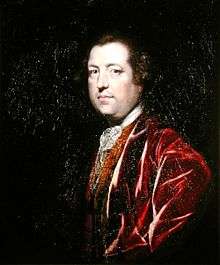 |
2 August 1766 | 4 September 1767 (died) | Whig | The Earl of Chatham | ||
| Lord North[17] (Held a courtesy title and sat in the Commons) |
 |
11 September 1767 | 27 March 1782 | Tory | |||
| The Duke of Grafton | |||||||
| Lord North | |||||||
| Lord John Cavendish |  |
27 March 1782 | 10 July 1782 | Whig | The Marquess of Rockingham | ||
| William Pitt the Younger |  |
10 July 1782 | 31 March 1783 | Whig | The Earl of Shelburne | ||
| Lord John Cavendish |  |
2 April 1783 | 19 December 1783 | Whig | The Duke of Portland (Fox-North Coalition) | ||
| William Pitt the Younger[17] |  |
19 December 1783 | 14 March 1801 | Tory | William Pitt the Younger | ||
| Henry Addington[17] | 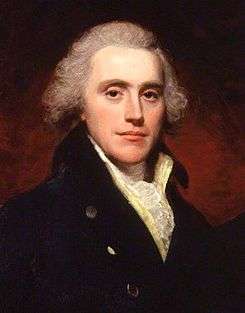 |
14 March 1801 | 10 May 1804 | Tory | Henry Addington | ||
| William Pitt the Younger[17][18] |  |
10 May 1804 | 23 January 1806 (died) | Tory | William Pitt the Younger | ||
| Lord Henry Petty |  |
5 February 1806 | 26 March 1807 | Whig | Lord Grenville (Ministry of All the Talents) | ||
| Spencer Perceval[18] |  |
26 March 1807 | 12 May 1812 (died) | Tory | The Duke of Portland | ||
| Spencer Perceval | |||||||
| Nicholas Vansittart |  |
12 May 1812 | 12 July 1817 | Tory | Lord Liverpool | ||
Chancellors of the Exchequer of the United Kingdom, 1817–1902
Although the Kingdoms of Great Britain and Ireland had been united by the Act of Union 1800 (39 & 40 Geo. III c. 67), the Exchequers of the two Kingdoms were not consolidated until 1817 under 56 Geo. III c. 98.[19] For the holders of the Irish office before this date, see Irish Chancellor of the Exchequer.
| Name | Portrait | Term of office | Political party | Prime Minister | |||
|---|---|---|---|---|---|---|---|
| Nicholas Vansittart |  |
12 July 1817 | 31 January 1823 | Tory | Lord Liverpool | ||
| F. J. Robinson |  |
31 January 1823 | 20 April 1827 | Tory | |||
| George Canning[18] |  |
20 April 1827 | 8 August 1827 (died) | Tory | George Canning | ||
| The Lord Tenterden (interim: Lord Chief Justice of the King's Bench) |
 |
8 August 1827 | 3 September 1827 | Tory | The Viscount Goderich | ||
| John Charles Herries |  |
3 September 1827 | 26 January 1828 | Tory | |||
| Henry Goulburn | |
26 January 1828 | 22 November 1830 | Tory | The Duke of Wellington | ||
| Viscount Althorp |  |
22 November 1830 | 14 November 1834 | Whig | The Earl Grey | ||
| The Viscount Melbourne | |||||||
| The Lord Denman (interim: Lord Chief Justice of the King's Bench) |
 |
14 November 1834 | 15 December 1834 | Whig | The Duke of Wellington (Caretaker Min.) | ||
| Sir Robert Peel, Bt |  |
15 December 1834 | 8 April 1835 | Conservative | Sir Robert Peel, Bt | ||
| Thomas Spring Rice |  |
18 April 1835 | 26 August 1839 | Whig | The Viscount Melbourne | ||
| Francis Baring |  |
26 August 1839 | 30 August 1841 | Whig | |||
| Henry Goulburn | |
3 September 1841 | 27 June 1846 | Conservative | Sir Robert Peel, Bt | ||
| Sir Charles Wood, Bt |  |
6 July 1846 | 21 February 1852 | Whig | Lord John Russell | ||
| Benjamin Disraeli |  |
27 February 1852 | 17 December 1852 | Conservative | The Earl of Derby | ||
| William Ewart Gladstone |  |
28 December 1852 | 28 February 1855 | Peelite | The Earl of Aberdeen (Coalition) | ||
| Sir George Cornewall Lewis, Bt |  |
28 February 1855 | 21 February 1858 | Whig | The Viscount Palmerston | ||
| Benjamin Disraeli |  |
26 February 1858 | 11 June 1859 | Conservative | The Earl of Derby | ||
| William Ewart Gladstone |  |
18 June 1859 | 26 June 1866 | Liberal | The Viscount Palmerston | ||
| The Earl Russell | |||||||
| Benjamin Disraeli |  |
6 July 1866 | 29 February 1868 | Conservative | The Earl of Derby | ||
| George Ward Hunt | _.jpg) |
29 February 1868 | 1 December 1868 | Conservative | Benjamin Disraeli | ||
| Robert Lowe |  |
9 December 1868 | 11 August 1873 | Liberal | William Ewart Gladstone | ||
| William Ewart Gladstone[17] |  |
11 August 1873 | 17 February 1874 | Liberal | |||
| Sir Stafford Northcote, Bt | 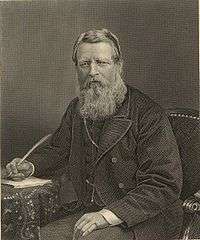 |
21 February 1874 | 21 April 1880 | Conservative | Benjamin Disraeli | ||
| William Ewart Gladstone[17] |  |
28 April 1880 | 16 December 1882 | Liberal | William Ewart Gladstone | ||
| Hugh Childers |  |
16 December 1882 | 9 June 1885 | Liberal | |||
| Sir Michael Hicks Beach, Bt | .jpg) |
24 June 1885 | 28 January 1886 | Conservative | The Marquess of Salisbury | ||
| Sir William Vernon Harcourt | 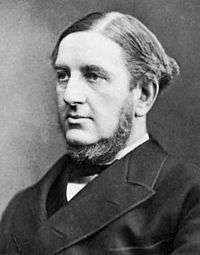 |
6 February 1886 | 20 July 1886 | Liberal | William Ewart Gladstone | ||
| Lord Randolph Churchill |  |
3 August 1886 | 22 December 1886 | Conservative | The Marquess of Salisbury | ||
| George Goschen |  |
14 January 1887 | 11 August 1892 | Liberal Unionist | |||
| Sir William Vernon Harcourt |  |
18 August 1892 | 21 June 1895 | Liberal | William Ewart Gladstone | ||
| The Earl of Rosebery | |||||||
| Sir Michael Hicks Beach, Bt | .jpg) |
29 June 1895 | 11 August 1902 | Conservative | The Marquess of Salisbury (Unionist Coalition) | ||
Chancellors of the Exchequer of the United Kingdom, 1902 to date
| Name | Portrait | Term of office | Political party | Prime Minister | |||
|---|---|---|---|---|---|---|---|
| Charles Ritchie |  |
11 August 1902 | 9 October 1903 | Conservative | Arthur Balfour (Unionist Coalition) | ||
| Austen Chamberlain |  |
9 October 1903 | 4 December 1905 | Liberal Unionist | |||
| H. H. Asquith |  |
10 December 1905 | 12 April 1908 | Liberal | Henry Campbell-Bannerman | ||
| David Lloyd George |  |
12 April 1908 | 25 May 1915 | Liberal | H. H. Asquith | ||
| Reginald McKenna |  |
25 May 1915 | 10 December 1916 | Liberal | H. H. Asquith (Coalition) | ||
| Andrew Bonar Law |  |
10 December 1916 | 10 January 1919 | Conservative | David Lloyd George (Coalition) | ||
| Austen Chamberlain |  |
10 January 1919 | 1 April 1921 | Conservative | |||
| Sir Robert Horne |  |
1 April 1921 | 19 October 1922 | Conservative | |||
| Stanley Baldwin |  |
27 October 1922 | 27 August 1923 | Conservative | Andrew Bonar Law | ||
| Stanley Baldwin | |||||||
| Neville Chamberlain |  |
27 August 1923 | 22 January 1924 | Conservative | |||
| Philip Snowden |  |
22 January 1924 | 3 November 1924 | Labour | Ramsay MacDonald | ||
| Winston Churchill | 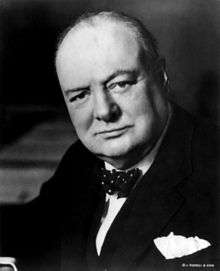 |
6 November 1924 | 4 June 1929 | Conservative | Stanley Baldwin | ||
| Philip Snowden |  |
7 June 1929 | 24 August 1931 | Labour | Ramsay MacDonald | ||
| 24 August 1931 | 5 November 1931 | National Labour | Ramsay MacDonald (1st National Min.) | ||||
| Neville Chamberlain |  |
5 November 1931 | 28 May 1937 | Conservative | Ramsay MacDonald (2nd National Min.) | ||
| Stanley Baldwin (3rd National Min.) | |||||||
| Sir John Simon |  |
28 May 1937 | 12 May 1940 | Liberal National | Neville Chamberlain (4th National Min.; War Coalition) | ||
| Sir Kingsley Wood[18] |  |
12 May 1940 | 21 September 1943 (died) | Conservative | Winston Churchill (War Coalition) | ||
| Sir John Anderson |  |
24 September 1943 | 26 July 1945 | National Independent | |||
| Hugh Dalton |  |
27 July 1945 | 13 November 1947 | Labour | Clement Attlee | ||
| Sir Stafford Cripps |  |
13 November 1947 | 19 October 1950 | Labour | |||
| Hugh Gaitskell | 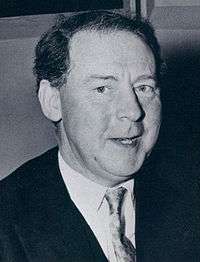 |
19 October 1950 | 26 October 1951 | Labour | |||
| R. A. Butler |  |
26 October 1951 | 20 December 1955 | Conservative | Sir Winston Churchill | ||
| Harold Macmillan |  |
20 December 1955 | 13 January 1957 | Conservative | Sir Anthony Eden | ||
| Peter Thorneycroft |  |
13 January 1957 | 6 January 1958 | Conservative | Harold Macmillan | ||
| Derick Heathcoat-Amory |  |
6 January 1958 | 27 July 1960 | Conservative | |||
| Selwyn Lloyd |  |
27 July 1960 | 13 July 1962 | Conservative | |||
| Reginald Maudling | 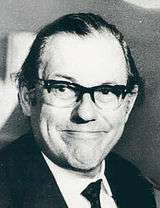 |
13 July 1962 | 16 October 1964 | Conservative | |||
| Sir Alec Douglas-Home | |||||||
| James Callaghan | |
16 October 1964 | 30 November 1967 | Labour | Harold Wilson | ||
| Roy Jenkins |  |
30 November 1967 | 19 June 1970 | Labour | |||
| Iain Macleod[18] | 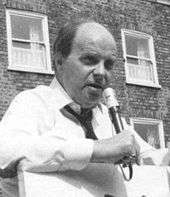 |
20 June 1970 | 20 July 1970 (died) | Conservative | Edward Heath | ||
| Anthony Barber |  |
25 July 1970 | 4 March 1974 | Conservative | |||
| Denis Healey |  |
5 March 1974 | 4 May 1979 | Labour | Harold Wilson | ||
| James Callaghan | |||||||
| Sir Geoffrey Howe |  |
4 May 1979 | 11 June 1983 | Conservative | Margaret Thatcher | ||
| Nigel Lawson |  |
11 June 1983 | 26 October 1989 | Conservative | |||
| John Major |  |
26 October 1989 | 28 November 1990 | Conservative | |||
| Norman Lamont |  |
28 November 1990 | 27 May 1993 | Conservative | John Major | ||
| Kenneth Clarke |  |
27 May 1993 | 2 May 1997 | Conservative | |||
| Gordon Brown |  |
2 May 1997 | 27 June 2007 | Labour | Tony Blair | ||
| Alistair Darling |  |
28 June 2007 | 11 May 2010 | Labour | Gordon Brown | ||
| George Osborne |  |
12 May 2010 | Incumbent | Conservative | David Cameron (I · II) | ||
See also
Notes and references
- ↑ Joseph Haydn, Horace Ockerby (ed.): The Book of Dignities, 3rd edition, Part III (Political and Official), p. 164. W.H. Allen & Co., London 1894, reprinted by Firecrest Publishing Ltd, Pancakes, 1969
- ↑ "Gordon Brown: Chancellor of the Exchequer". Encyclopedia II. Experiencefestival.com. Retrieved 2 May 2010.
- ↑ "Monetary Policy | Monetary Policy Committee (MPC) | Framework". Bank of England. 6 May 1997. Retrieved 2 May 2010.
- ↑ "History of Number 11 Downing Street". UK Government. Retrieved 16 October 2014.
- ↑ "Local History". Burnham Parish Council.
- ↑ http://www.timesonline.co.uk/tol/news/politics/article2532776.ece Archived 28 October 2012 at the Wayback Machine
- ↑ The Guardian, 11 March 2011
- ↑ Alistair Darling, Back from the Brink(2011)
- ↑ "The Budget and Parliament". Parliament of the United Kingdom. Retrieved 8 November 2015.
- ↑ Lydall, Ross (6 March 2008). "Chancellor names his preferred Budget tipple—a glass of plain London tap water". The Scotsman. Retrieved 2 May 2010.
- ↑ Murphy, Joe (5 March 2008). "Darling chooses tap water for Budget Day to support Standard campaign". London Evening Standard. Retrieved 9 February 2012.
- ↑ "Photograph".
- ↑ "Portrait".
- ↑ Vina, Gonzalo (10 December 2010). "www.bloomberg.com". Bloomberg.
- ↑ DNB
- ↑ DNB
- 1 2 3 4 5 6 7 8 Also served as Prime Minister for some or all of their Chancellorship.
- 1 2 3 4 5 6 Died in office.
- ↑ Joseph Haydn, Horace Ockerby (ed.): The Book of Dignities, 3rd edition, Part X (Ireland), p. 562. W.H. Allen & Co., London 1894, reprinted by Firecrest Publishing Ltd, Bath, 1969
External links
| Wikimedia Commons has media related to Chancellors of the Exchequer. |
| ||||||||
| ||||||||||||
| |||||||||||||||||||||
| ||||||||||||||||||||||||||||||||||||||||||||||||||||||||||||||||
| ||||||||||||||||||||||||


